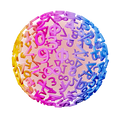How to Solve Equations (Change Sides, change sign)
Video Crash Courses
Want to watch animated videos and solve interactive exercises about moving numbers around in equations?
Click here to try the Video Crash Course called “Linear Equations”!
You now know that equations have to be balanced. That means that if you do something on one side of an equation, you have to do the same on the other side as well, to keep it from getting out of balance.
In order to isolate , you’ll want to add or subtract things to get rid of a term on one side of the equation. This is what you do:
Example 1
Subtracting on Both Sides
You want to remove the on the left side (LS). If you subtract from the LS, the disappears. You have to subtract the you subtracted from the left side from the right side (RS) as well. That means that the showed up on the other side of the equal sign, but with the opposite sign!
Example 2
Adding on Both Sides
You want to remove the on the LS. If you add to the LS, disappears. The you added to the LS has to be added to the RS as well. That means that the showed up on the other side of the equal sign, but with the opposite sign!
There is a simpler way than subtracting or adding on both sides. That method is called change sides, change sign.
Rule
The Change Sides, change sign Method
- 1.
- Change sides of the term you want to remove so that it’s on the other side of the equal sign.
- 2.
- Change the sign of the term you just moved.
Example 3
Positive Change Sides, change sign, to Negative
is changed to the RS of the equation. We change the sign so that becomes .
Example 4
Negative Change Sides, Change Sign, to Positive
is changed to the RS of the equation. We change its sign so that becomes .
Why Can You Change Sides, change sign?
Why can you just change sides, change sign, as much as you like? Imagine that the scales are balanced. When you move a term over to the other scale, you would think it would get heavier, but because you change the sign at the same time, it’s like that same term was removed from or added to the other side of the scale as well!
Think About This
The change sides, change sign rule is a simplified way of completing the same action on both sides of the equal sign.
Math is amazing that way—when you learn new rules, your life becomes easier!
Example 5
Solve the equation .
Example 6
Solve the equation .
Example 7
Solve the equation .
Example 8
Solve the equation .





















